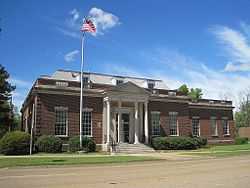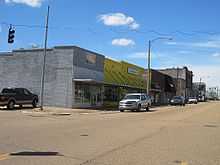Brinkley, Arkansas
| Brinkley, Arkansas | |
|---|---|
| City | |
 | |
| Motto: "Great hospitality Aways at the center" | |
 | |
| Coordinates: 34°53′25″N 91°11′30″W / 34.89028°N 91.19167°WCoordinates: 34°53′25″N 91°11′30″W / 34.89028°N 91.19167°W | |
| Country | United States |
| State | Arkansas |
| County | Monroe |
| Government | |
| • Mayor | Billy Hankins |
| Area | |
| • Total | 6 sq mi (15.4 km2) |
| • Land | 5.5 sq mi (14.2 km2) |
| • Water | 0.5 sq mi (1.2 km2) |
| Elevation | 210 ft (64 m) |
| Population (2000) | |
| • Total | 3,940 |
| • Density | 656.7/sq mi (255.8/km2) |
| Time zone | Central (CST) (UTC-6) |
| • Summer (DST) | CDT (UTC-5) |
| ZIP code | 72021 |
| Area code(s) | 870 |
| FIPS code | 05-08950 |
| GNIS feature ID | 0057440 |
| Website | www.brinkleyar.com |
Brinkley is the most populous city in Monroe County, Arkansas, United States. The population was 3,940 at the 2000 census.
It is located almost exactly halfway between Little Rock, Arkansas and Memphis, Tennessee; the city has used the slogan "We'll Meet You Half-Way" in some of its advertising campaigns.
Geography
Brinkley is located at 34°53′25″N 91°11′30″W / 34.89028°N 91.19167°W (34.890152, -91.191741).[1]
According to the United States Census Bureau, the city has a total area of 5.9 square miles (15 km2), of which 5.5 square miles (14 km2) is land and 0.4 square miles (1.0 km2) (7.59%) is water.
Demographics
As of the census[2] of 2000, there were 3,940 people, 1,543 households, and 972 families residing in the city. The population density was 719.0 people per square mile (277.6/km²). There were 1,731 housing units at an average density of 315.9 per square mile (122.0/km²). The racial makeup of the city was 49.09% White, 49.05% Black or African American, 0.18% Native American, 0.30% Asian, 0.05% Pacific Islander, 0.30% from other races, and 1.62% from two or more races. 1.12% of the population were Hispanic or Latino of any race.
There were 1,543 households out of which 31.8% had children under the age of 18 living with them, 39.5% were married couples living together, 20.8% had a female householder with no husband present, and 37.0% were non-families. 33.7% of all households were made up of individuals and 15.8% had someone living alone who was 65 years of age or older. The average household size was 2.48 and the average family size was 3.23.
In the city the population was spread out with 31.0% under the age of 18, 8.4% from 18 to 24, 22.4% from 25 to 44, 20.7% from 45 to 64, and 17.4% who were 65 years of age or older. The median age was 36 years. For every 100 females there were 81.5 males. For every 100 females age 18 and over, there were 73.5 males.
The median income for a household in the city was $19,868, and the median income for a family was $27,820. Males had a median income of $26,117 versus $16,714 for females. The per capita income for the city was $12,441. About 23.8% of families and 30.9% of the population were below the poverty line, including 38.6% of those under age 18 and 18.7% of those age 65 or over.
Education
Public education for elementary and secondary school students is provided by the Brinkley School District, which leads to graduation from Brinkley High School.
History
In 1852, a land grant for the construction of rail lines was given to the Little Rock and Memphis Railroad Company, led by Robert Campbell Brinkley as its President. Robert C. Brinkley, born in North Carolina, lived in Memphis where he served a public career of "noble deeds and generous conduct" and for many years served as the President of Planters Bank of Memphis.
Between 1852 and 1869, the settlement was called "Lick Skillet." When the day’s work was completed, the railroad construction crew, mostly all immigrants from neighboring towns, cooked their supper over an open fire and returned to their homes when the last "skillet was licked."
The construction of the rail lines between Little Rock and Memphis brought the City of Brinkley into being. Brinkley is situated in the northern part of Monroe County, the halfway point between the two larger cities. It was laid out in the winter of 1869 on lands belonging to the railroad.
A Petition Request was granted to incorporate Brinkley on August 6, 1872, at which time the town had 50 qualified voters. The original charter was filed with the Secretary of State of Arkansas on August 21, 1872. The Texas and St. Louis Railway was built through Brinkley in 1882.

From its ties to the transportation industry, the City of Brinkley continues to maintain a position at the center of major transportation arteries. Brinkley is located in Monroe County in the rich relics from the past and rolling farmlands of the Arkansas Delta. The halfway point between Little Rock and Memphis, it is a convenient oasis for travelers along Interstate 40 (I-40), one of the busiest interstates in the United States. The city is also located on U.S. Route 49 (US 49), providing transit north-south, and US 70, an additional east-west corridor.
Duck hunting is a major source of income for the city during the months of November, December, and January. With many rice fields flooded for the winter, and being located on the Mississippi Flyway, ducks are very prevalent throughout the region. Men, and women, from around the United States come to Brinkley to go on guided hunts throughout the entire season.
Notable people
- Alvertis "Al" Bell, born in Brinkley, disc jockey, record producer and songwriter executive at Stax Records.
- Jon Brittenum, former Arkansas Razorbacks football player and member of the San Diego Chargers.
- Curtis Burrow, former member of the Green Bay Packers.
- Jerry Eckwood, former Arkansas Razorbacks football player and member of the Tampa Bay Buccaneers.
- Louis Jordan, born in Brinkley, jazz and early rock & roll musician.
- Herbert "Flight Time" Lang, current member of the Harlem Globetrotters basketball team and 2 time participant of the Amazing Race.
Recent Eco-Tourism Activities
Brinkley is located near the Cache River National Wildlife Refuge, where in February 2004 the ivory-billed woodpecker was purportedly rediscovered after having thought to be extinct for over 60 years. Brinkley has attempted to capitalize on its good fortune of being the largest city near the Refuge and the rediscovery of the woodpecker:
- A billboard on eastbound Interstate 40 proclaims Brinkley as "The Home of the Ivory-Billed Woodpecker"
- One motel has changed its name to "The Ivory-Billed Inn"
- A local resident has opened a shop, "The Ivory-Billed Nest", devoted exclusively to ivory-billed paraphernalia
- One local barbershop offers an "ivory-billed" haircut (a variation of the mohawk complete with red tinting)
- Gene's Restaurant and Barbecue, a popular local restaurant, offers an "ivory-billed burger" and an "ivory-billed salad" on its menu; in addition, two of the initial rediscoverers of the ivory-billed woodpecker have written a children's book which mentions Gene's.
In addition to the ivory-billed sightings, since July 2005 at least two confirmed reports of bald eagle nests have been found in the Monroe County area. Further, the swamps of the Cache River are believed to contain among the oldest cypress trees in the United States.
Brinkley opened a convention center in 1996 which can seat up to 600 people; in February 2006 the center hosted a conference commemorating the second anniversary of the ivory-billed woodpecker's rediscovery.
See also
Climate
The climate in this area is characterized by hot, humid summers and generally mild to cool winters. According to the Köppen Climate Classification system, Brinkley has a humid subtropical climate, abbreviated "Cfa" on climate maps.[3]
References
| Wikimedia Commons has media related to Brinkley, Arkansas. |
- ↑ "US Gazetteer files: 2010, 2000, and 1990". United States Census Bureau. 2011-02-12. Retrieved 2011-04-23.
- ↑ "American FactFinder". United States Census Bureau. Retrieved 2008-01-31.
- ↑ Climate Summary for Brinkley, Arkansas
External links
| ||||||||||||||||||||
